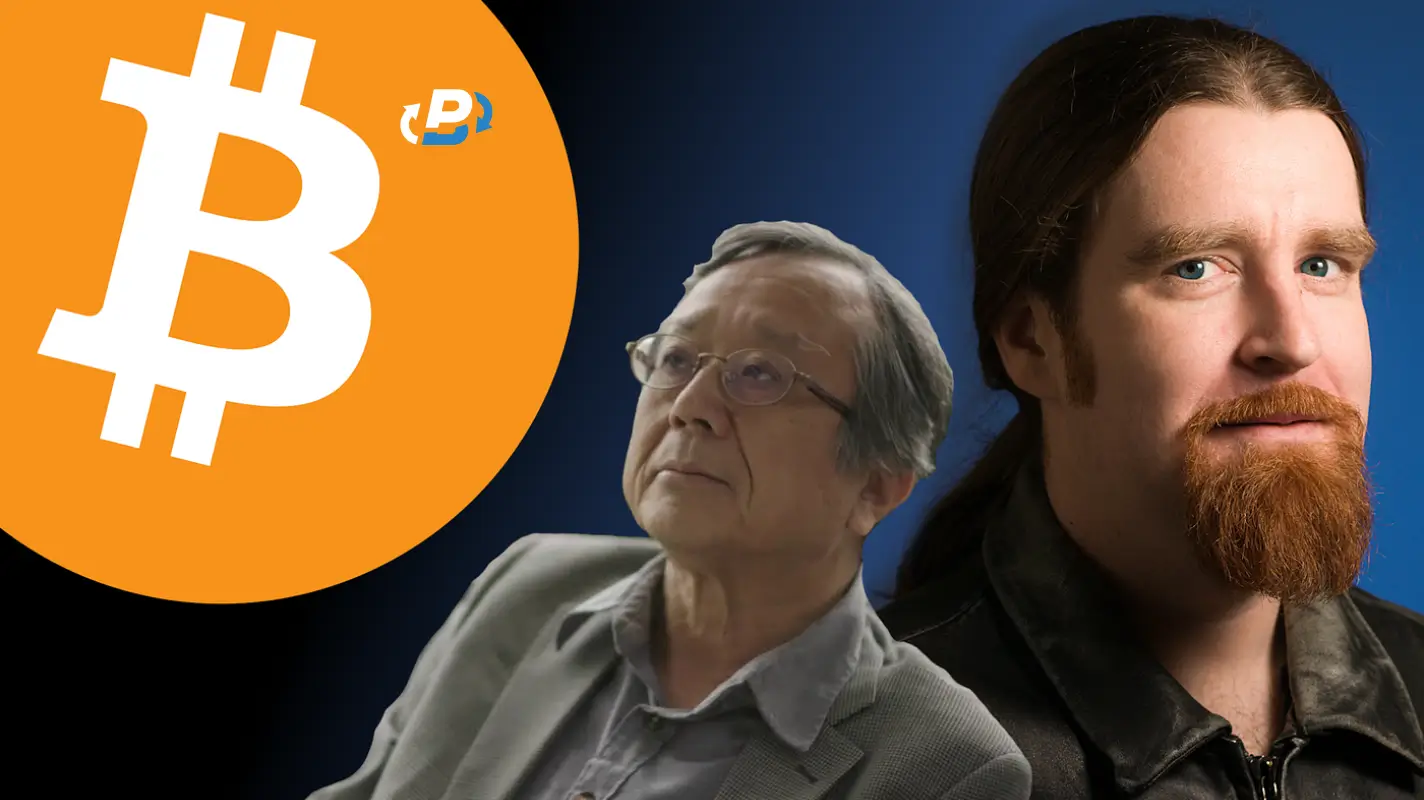Bitcoin and cryptocurrencies in general, are deeply rooted in the cryptographic and cypherpunk movements that emerged in the late 20th century. The cypherpunk movement, which began in the late 1980s and early 1990s, consisted of a group of privacy-focused cryptographers, computer scientists, and activists who believed in using strong cryptography to promote personal privacy and freedom in the digital age. This is important because many of the key figures involved in Bitcoin’s early development and its underlying tech came from that background. A key influence on Bitcoin’s development was the work of David Chaum, a cryptographer who pioneered digital cash concepts with DigiCash and eCash in the 1980s. These systems used cryptographic protocols to enable anonymous digital transactions. Later, in the 1990s and 2000s, advancements in cryptographic research by figures like Adam Back (creator of Hashcash), Hal Finney, Nick Szabo (developer of Bit Gold), and Wei Dai (creator of B-Money) contributed to the fundamental ideas that Bitcoin would later implement.
Among those names is Len Sassaman, a man strongly involved in the cypherpunk movement and one of the main suspects of being the elusive Bitcoin creator. So, is Len Sassaman Satoshi? Probably not, but he is a suspect for several reasons: the near-simultaneous timing of his death and Satoshi's last online activity, his professional relationships with key Bitcoin figures like Hal Finney and Adam Back, his familiarity with anonymous remailers (a tool famously used by Satoshi), and his strong privacy advocacy all create a possible link. His preference for a low profile and work on cryptographic studies relevant to Bitcoin's design further bolsters this belief. But his wife denied the allegations. At PlasBit, we’re fascinated by his character and story, so let’s take a deeper look into his life and the theory.
The Mystery Behind Len Sassaman
The speculation regarding Sassaman being Satoshi isn’t new. However, while there have been theories before, this particular one (and some others) gained a lot of traction with the release of the HBO documentary ‘Money Electric: The Bitcoin Mystery’ in October 2024. The documentary delves into the history of Bitcoin and the enduring enigma of its creator, Satoshi Nakamoto. This fueled a lot of people wanting to know who Satoshi is, and by proxy, Sassaman came into the equation. There are numerous reasons why. For starters, he had the expertise to do it, and his roots were all about cryptography. From a young age, Len demonstrated a self-taught aptitude for technology, with a distinct interest in cryptography and protocol development. He graduated high school in Pennsylvania, in 1998, and at eighteen years old, was contributing to the Internet Engineering Task Force. There, he worked on the TCP/IP protocol (the foundation of the internet, btw.) and the subsequent development of the Bitcoin network. After moving to the Bay Area in 1999, Len quickly became active in cypherpunk circles, sharing a residence with Bram Cohen, the creator of BitTorrent. He was also on the cypherpunk mailing list, the same one where Satoshi Nakamoto first revealed Bitcoin.
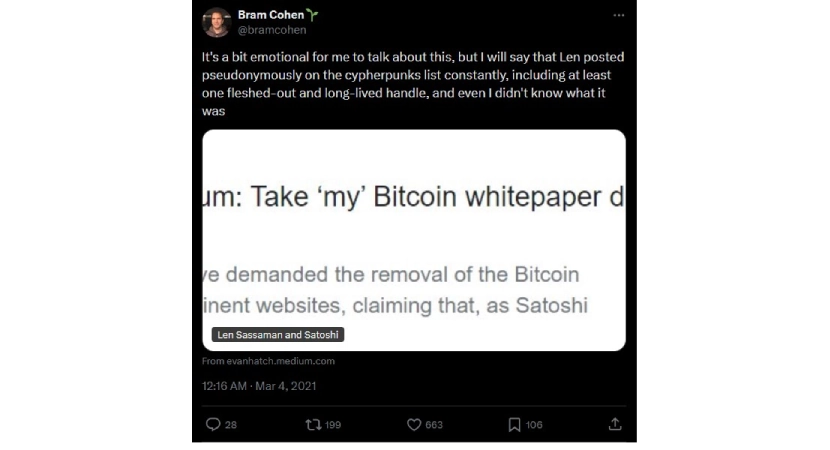
(Image credit: X)
As time passed, Sassaman became a well-known cypherpunk and staunch advocate for privacy. He did much for the cypherpunk movement with his role in the development and maintenance of many projects associated with it, such as the Mixmaster anonymous remailer. Sassaman quickly became a recognized expert in public-key cryptography - a core component of Bitcoin. By 22, he was presenting at conferences and had co-founded a public key crypto startup with open-source advocate Bruce Perens. Following the failure of his startup during the Dot-com bubble, Len joined Network Associates to take part in the development of PGP (Pretty Good Privacy) encryption, a technology of significant relevance to Bitcoin.
Through his involvement on the 2001 release of PGP7, Sassaman helped create ways for the encryption protocol to work smoothly with other OpenPGP programs, eventually connecting him with some of the most prominent people in the cryptography world. Furthermore, he helped the GNU Privacy Guard implementation of OpenPGP and collaborated with PGP inventor Phil Zimmerman on the creation of a new cryptographic protocol. Sassaman was also responsible for the lead maintenance of the Mixmaster anonymous remailer and the Randseed remailer. What’s interesting about this is that an anonymous remailer functions similarly to Bitcoin nodes, receiving and processing messages without disclosing their origin. Bitcoin's blockchain, on the other hand, provides pseudo-anonymity, allowing users to choose their desired level of privacy. Thus, it’s plausible Satoshi used an anonymous remailer to keep his identity a secret.
Sassaman’s Research and Academia
In 2004, Len's cryptographic skills earned him a place at the Computer Security and Industrial Cryptography (COSIC) research group of Katholieke Universiteit Leuven (Belgium) as a PhD student in 2004. He worked there until his death in 2011, amassing an impressive record of 45 publications and 20 conference committee positions. At COSIC, Sassaman made enormous contributions to privacy and cryptography, notably in anonymous communication systems. His principal project, the Pynchon Gate, built upon existing remailer technology to enable pseudonymous information retrieval across a decentralized network, removing the requirement for a trusted third party and thereby improving both security and privacy.
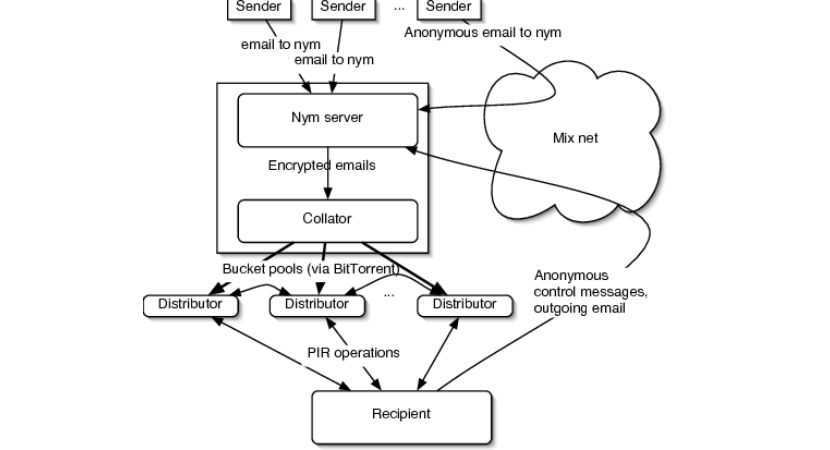
(Image credit: ResearchGate)
This and the entire work during his time spent at COSIC is very relevant to Bitcoin. What’s more, it has been speculated that Satoshi was some kind of academic, where Gavin Andersen, the founder of Bitcoin Foundation said: “I think he’s an academic, maybe a post-doc, maybe a professor who just doesn’t want the attention.” If that’s not interesting, how about this - Gavin also worked with Satoshi. Besides, Satoshi’s comments on Bitcointalk.org were much more prevalent during summer and winter breaks, compared to the late spring or end of the year, corresponding to the typical timeframe for academic final examinations.

(Image credit: Medium)
The Europe Connection
A few details from Sassaman’s life on the old continent add fuel to the is Len Sassaman Satoshi hypothesis. One of the newer ones stems from October last year, when David Michel, founder of SolidMarket, published an article in Global Security Magazine presenting some compelling evidence. You see, the Bitcoin whitepaper references parts from the "Twentieth Symposium on Information Theory in the Benelux," a rare compilation of presentations from a 1999 Belgian symposium. The article states that the book was inaccessible online until 2020, which suggests that Satoshi had direct access to it. We know that Len Sassaman studied and was living in Belgium at the time, so it's reasonable to conclude that, at the very least, he had access to this book.
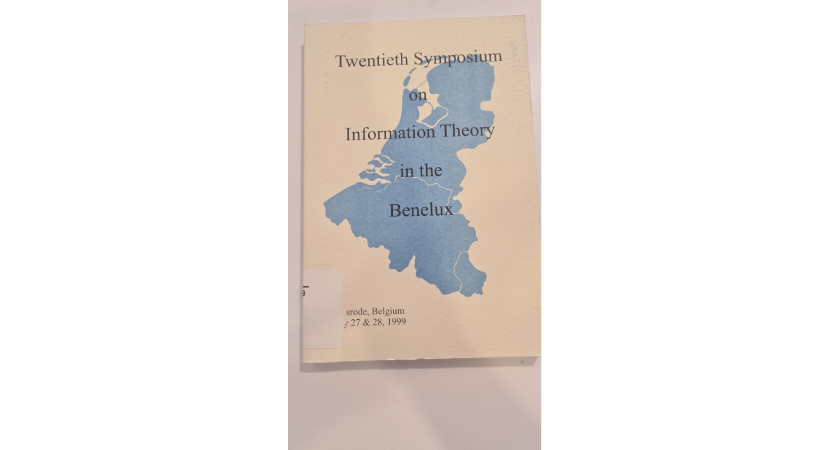
Heck, he even took a photo of the shelf with the book while attending a seminar (the yellowish book on the right, next to the big blue book).


This is pretty much proof that he had the necessary resources and knowledge referenced in the Bitcoin whitepaper. Is that enough to peg him as Satoshi, is a different matter. Another intriguing tidbit is that both he and his wife, Meredith L. Patterson deleted their tweets during the period surrounding Bitcoin's launch. Could this indicate an effort to conceal involvement in Bitcoin's creation? His wife tweeted this on December 7, 2010: "Bitcoin isn't ready for prime time yet, according to its creator. Interested people can help finish it, though!" This message, posted shortly before Satoshi's final public communication, could imply she had direct knowledge of Satoshi's intentions, further linking Sassaman to Bitcoin's origin. Though, last year, she said it was just her interpretation of the Bitcoin whitepaper.
Use of British English
Satoshi used British English and dd/mm/yyyy date format. Additionally, during his email conversation with Mike Hearn, he refers to Euros as his currency of choice.
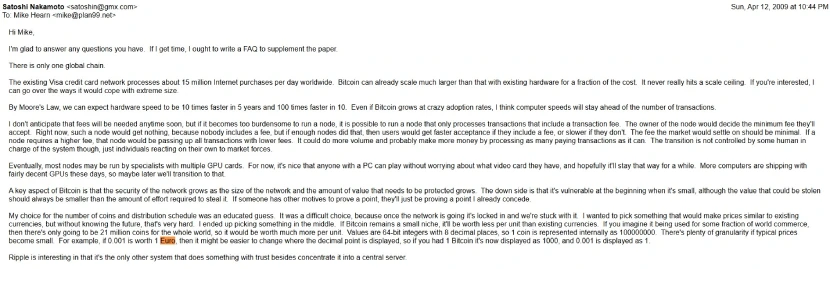
(Image credit: Plan99)
Also, a headline from the print version of The Times newspaper that was only available in Europe and the UK was embedded in Bitcoin's Genesis Block. The Times was a major newspaper in Belgium in 2009, so much so that it was in the top ten in terms of circulation. Combined with the analysis of Satoshi’s posting, all of this points that Satoshi was either European or at least was living in Europe. His own posts and code commits are also very similar to Sassaman’s post activity. One of the most peculiar details regarding the question is Len Sassaman Satoshi, is the fact that even though he was an American born in Pennsylvania, Sassaman used the same British English as Satoshi did. Words like flat, grey, bloody, maths, and similar were routinely part of his online vocabulary.

(Image credit: X)
Sassaman’s Connection to Key Bitcoin Players
Sassaman has known and been connected to numerous important people in Bitcoin history. For instance, he was likely friends with Hal Finney as they both worked on PGP. Finney aided PGP’s development and helped define the RFC 4880 standard, which solves compatibility issues and allows for seamless communication between different OpenPGP software implementations. After Satoshi, Finney was the second contributor to Bitcoin's code, as well as the first known person to run Bitcoin’s software and receive a Bitcoin transaction from Satoshi Nakamoto in January 2009. Sassaman also knew Adam Back, who was known for Hashcash, a proof-of-work (PoW) system that later became a key component in Bitcoin’s mining process.
They were both part of the cypherpunk mailing list and active in cryptographic studies and digital security. In addition, Back's contributions to a research paper by Sassaman and a Mixmaster memo demonstrate a direct working relationship between the two. Currently, Adam Back is the CEO of Blockstream, a major blockchain development company focused on Bitcoin scalability and privacy. Sassaman also probably had links to several more cypherpunks who were related to Bitcoin in one way or another, such as Wei Dai and Nick Szabo (more on him later). Sassaman and Dai were both active in the cypherpunk mailing list (we’re beginning to see a pattern here), where discussions about digital cash and cryptographic privacy were common. Dai created b-money, one of the first conceptual frameworks for a decentralized cryptocurrency, and Satoshi Nakamoto cited b-money in the Bitcoin whitepaper.
Sassaman’s Death and Satoshi’s Disappearance
Sadly, Len Sassaman took his own life on July 3, 2011. Reports indicate that he was struggling with depression due to long-term health issues, including chronic pain. His funeral was held in Leuven, Belgium, on July 9. He was memorialized in the Bitcoin blockchain as ASCII art of his face and some words about him, specifically within Block 138725.

(Image credit: Wikipedia)
Coincidentally, Satoshi Nakamoto vanished from online activity in late 2010, having his final public message on December 12, 2010 - one of the reasons why people wonder is Len Sassaman Satoshi. By then, Nakamoto had already transferred maintenance of Bitcoin's open-source code to Gavin Andresen. In late April, shortly before Sassaman’s death, Satoshi's last private communication was an email to developer Michael Hern, where he stated that he moved on to other things.
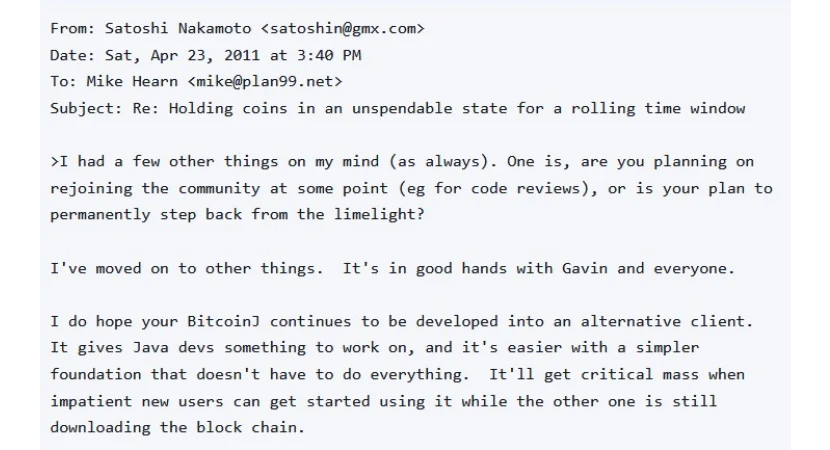
(Image credit: Bitcoin.com)
Len Sassaman Cat
Unusually (but totally in character), Sassaman revealed his furry pet to the world. But why is Len Sassaman cat important? Len had a cat named Sasha, which he introduced in a 2011 tweet, and in October 2024, people launched a memecoin called Sasha Cat ($SASHA) on the Solana blockchain, trying to make money off of the hype around the HBO documentary. The token became available for trading on decentralized exchanges like Raydium and Jupiter DEX. Shortly after its launch, $SASHA experienced a significant surge, with its market capitalization reaching approximately $418,000. Nonetheless, the token's value proved volatile, experiencing a 60% decline within a day after the initial rally.
The Never-Ending Quest to Uncover the Real Identity of Satoshi
It’s all too likely that the quest to find the real identity of Satoshi will never stop, and Len Sassaman isn’t the only candidate who fits the bill.
Peter Todd
A name that has been put in the spotlight after HBO’s documentary, Peter Todd is a cryptographer, software developer, and Bitcoin Core contributor known for his expertise in blockchain security, cryptographic protocols, and decentralized technologies. He has worked on PoW optimizations and anti-censorship mechanisms in Bitcoin. Todd was involved in the Bitcoin community very early on, adding to the protocol’s development and discussions about Bitcoin’s technical direction. He participated in high-level cryptographic discussions during Bitcoin’s early days. Satoshi Nakamoto, as is widely understood, had a high level of cryptographic and computer science knowledge. Peter Todd is known for his cryptographic contributions, including the development of OpenTimestamps - a protocol used for securely timestamping documents using Bitcoin’s blockchain. In particular, Todd’s work on Bitcoin's PoW, scalability, and transaction security is considered very advanced and suggests a strong background in blockchain technology that some attribute to Satoshi. Todd has not been a prominent Satoshi suspect until the HBO’s documentary, in which he was named to be Satoshi Nakamoto. The documentary's evidence is based on forum posts from 2010, where Todd allegedly finished Satoshi's sentences. He denies the accusation, citing the documentary's marketing motives.
Dorian Nakamoto
A Japanese-American engineer, Dorian Nakamoto gained international attention in 2014 when Newsweek claimed he was the mysterious creator of Bitcoin. Interestingly enough, he was born as Satoshi Nakamoto, but he legally changed his first name to Dorian in 1973. His professional background does seem like someone who has Satoshi’s skills, as he worked as a systems engineer on classified defense projects and as a computer engineer for tech and financial information companies. While he was a well-educated engineer, he wasn’t a part of the cypherpunk movement. Newsweek's primary evidence centered on Dorian's Japanese-American heritage, his experience with top secret work, his physics degree from California Polytechnic, and his ambiguous response when questioned. He was also very libertarian-leaning, and curiously, lived close to Hal Finney's residence. Dorian Nakamoto later clarified that he felt he had been wronged and that he had misunderstood the reporter’s questions, mistaking them for inquiries about a classified project he had undertaken with Citibank.
As one might expect, Nakamoto consistently denied any involvement with Bitcoin, and he even clarified in a public statement that he had never heard of it until his son mentioned it after the reporter's questions. While he did share the same name and relevant technical background, there wasn't much else to tie him to Satoshi, and due to the article his personal life was turned upside down with all the media intrusion. This started a good deal of discussions about journalistic ethics and privacy rights.
Hal Finney
We already mentioned Finney as a man who was likely Sassaman’s friend, but there is much more to him. He was a pioneering American computer scientist and cryptographer, renowned for his notable contributions to digital privacy and cryptocurrency. After graduating with a Bachelor of Science in Engineering from the California Institute of Technology in 1979 he worked on console games, before joining PGP Corporation as a developer, working on advancements in encryption and digital security. He was an active member of the cypherpunk mailing list in the early 1990s, and was deeply involved in discussions on digital privacy and cryptography. Finney operated two anonymous remailers, allowing users to send emails without revealing their identities. In 2004, he developed the first reusable proof-of-work system, a precursor to Bitcoin's proof-of-work mechanism. On January 12, 2009, Finney received the first Bitcoin transaction from Satoshi Nakamoto, marking a historic moment in cryptocurrency history. He also engaged in early correspondence with Bitcoin's creator, providing feedback and suggestions to refine the protocol. He’s also the author of the first Bitcoin tweet in history.

(Image credit: X)
Considering his expertise, views, and the fact that a man originally named Satoshi Nakamoto lived close by, there has been speculation about him being Bitcoin’s creator. Nevertheless, that’s likely not true since one of the key pieces of evidence disputing the claim is that Finney, known for his passion for running, took part in a 10-mile race in Santa Barbara, California, on April 18, 2009. At the same time he was running, Satoshi Nakamoto was communicating with Mike Hearn, a developer involved with early Bitcoin. In August 2009, Finney was diagnosed with amyotrophic lateral sclerosis (ALS), and he passed away on August 28, 2014, in Phoenix, Arizona. Honoring his wishes, his body was cryopreserved by the Alcor Life Extension Foundation.
Nick Szabo
A prominent American of Hungarian descent, Nick Szabo is a computer scientist, legal scholar, and cryptographer, renowned for his pioneering work in digital contracts and cryptocurrencies. He earned a degree in Computer Science from the University of Washington in 1989 and later obtained a Juris Doctor from George Washington University Law School. He didn't stop there, as in 1994, Szabo introduced the concept of “smart contracts,” aiming to bring the practices of contract law to the design of electronic commerce protocols between strangers on the internet. Four years later, he designed Bit Gold, a decentralized digital currency mechanism. While Bit Gold remained unrealized, Szabo's concept is generally seen as a foundational step towards the creation of Bitcoin.
His extensive background in digital currencies and cryptography is probably the main reason why some theorized that he might be Satoshi Nakamoto in the first place. A 2013 analysis by blogger Skye Grey linked Szabo to the Bitcoin whitepaper through linguistic similarities, and then there are the shared similarities with Bit Gold’s and Bitcoin's architecture, suggesting he had the requisite knowledge to create the world's first cryptocurrency. Also, in a 2017 interview on the Tim Ferriss Show, Szabo was caught saying: “I designed Bitcoin - gold, with two layers…” That was more than enough for people to wonder if he had a Freudian slip, additionally fueling the belief that he is Satoshi. Despite the speculation, Szabo has consistently denied being Satoshi Nakamoto. In a 2014 email to financial author Dominic Frisby, he stated: “I'm afraid you got it wrong doxing me as Satoshi, but I'm used to it.”
Satoshi Hada
The latest in the long line of potential Satoshi Nakamotos, Satoshi Hada actually came up as a viable “candidate” from a Reddit user. He found out that during the Crypto 98 conference, where Hal Finney had a presentation, the names Satoshi Hada and Toshiaki Tanaka appeared together on the event program's information page. Further investigation led to a tweet that showed three names along with a research paper about public and private keys. The names were Satoshi Hada, Toshiaki Tanaka, and Naohiko Uramoto. Combining the three forms Satoshi NakaMoto. The URL to the research paper is linked to IBM, suggesting that Hada has ties to the IT giant.
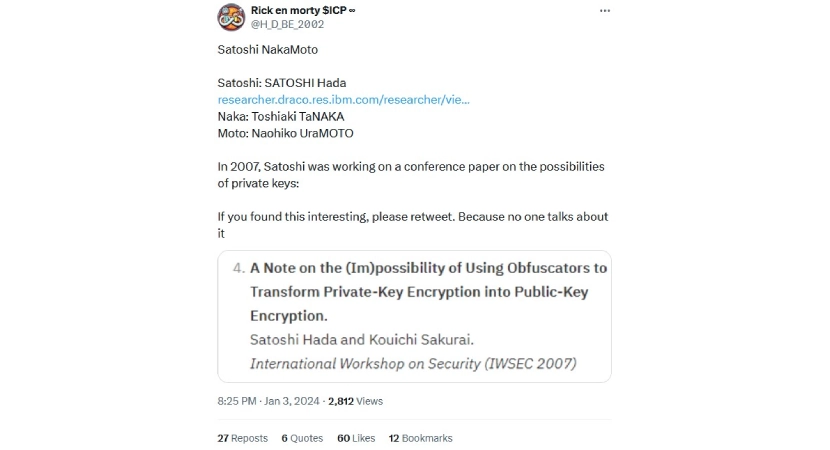
(Image credit: X)
Online searches indicate Hada's participation in the Cypherpunk group, with an email dating back to December 2001 being discovered. There’s also the matter of his X profile. A comment, written in reverse, was posted in 2021 in response to his 2017 tweet. It mentioned Satoshi Nakamoto, indicating it could be a pseudonym for at least three IBM researchers who conducted early blockchain work before Bitcoin. While this theory presents an intriguing narrative (just as we like them at PlasBit), it remains speculative. That said, there’s more than enough basis for people to add another person (or persons) to the mystery that is Satoshi Nakamoto’s identity.
Len Sassaman Death Note
There were rumors about Sassaman leaving a suicide message that left many puzzled. So what is the mysterious Len Sassaman death note? He allegedly left a suicide note with 24 random words, which could be interpreted as the 24-word seed phrase used in crypto wallets. It's probably not true because seed phrases were introduced in 2013 with BIP39, two years after his death in 2011.
Rest In Peace, Len
We at PlasBit find Len Sassaman’s story equally fascinating and tragic. His work and memory will forever be ingrained in the cypherpunk movement, as well as in cryptography. The idea of him being the Bitcoin creator will probably never go away, and we can’t deny there are solid reasons to think he is the same person as Satoshi Nakamoto. That said, there is no 100% concrete proof, and his wife always denied his involvement. But that certainly won’t stop people from speculating is Len Sassaman Satoshi. Even though he presumably isn’t, at the very least, he indirectly contributed to the creation of the most well-known cryptocurrency. And for that, Len has our respect and gratitude.




